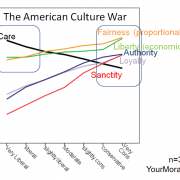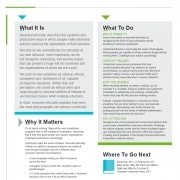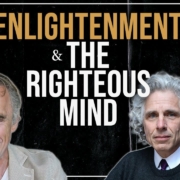Teaching Behavioral Ethics across Disciplines
Tigran W. Eldred, Associate Professor of Law, New England Law | Boston
Almost a decade ago, shortly before I started law teaching, I worked as an appellate lawyer representing clients who had been convicted of serious crimes. In one case, I recall having a very uncomfortable conversation with the lawyer who, I was convinced (and a court later agreed), had made a number of significant mistakes when he represented my client at trial. What struck me about the conversation then, and what remains with me now, was my strong sense that the lawyer was rationalizing his very poor performance despite his ethical duty to be candid with me about his work on the case. Was the lawyer being deceitful in covering up his many mistakes, or did he truly believe that his conduct had been reasonable even though, to an observer, it was so apparent that his performance had been deficient?
This question stayed with me when I began teaching law students about their ethical duties, including the obligations lawyers possess to avoid conflicts of interests. Fortunately, around the same time, I came across a book by many of the collaborators to EthicalSystems.org, entitled Conflicts of Interest: Challenges and Solutions in Business, Law, Medicine, and Public Policy. This collection of essays, and in particular the chapter on Bounded Ethicality by Dolly Chugh, Max Bazerman and Mahzarin Banaji, opened my eyes to the psychological reasons why it is so easy for professionals, lawyers included, to overlook their own ethical transgressions. I also realized that, if law students are to appreciate their ethical obligations, I would need to do more than to teach the formal rules that govern their future behavior. Instead, they would benefit from learning about the body of research that has since developed into the emerging field of behavioral ethics.
Because I am not a psychologist, my first challenge was to become familiar enough with the research on behavioral science to teach it to my students. This led me to immerse myself in the literature of the field. Fortunately, EthicalSystems.org has now made this a much more manageable task by providing a well-organized, central repository for much of the relevant research in the field. It should be the first stop for anyone interested in teaching ethics from a behavioral perspective (for law professors, there is also a trove of specific literature applying behavioral research to legal ethics, including recent scholarship summarizing the field. Perhaps the most comprehensive, by Jennifer Robbennolt & Jean Sternlight, is entitled Behavioral Legal Ethics).
Next, I started to look for ways to integrate the research on behavioral ethics into classroom discussions in a fashion that would engage my students, most of whom have little or no training in psychology. What follows are a few examples of the approach I have developed in teaching my semester long course in professional responsibility, which I share as one perspective on how to incorporate a behavioral approach into professional school education.
My working hypothesis has been that students will better understand the limits of rational deliberation, and be more willing to engage in a conversation about issues such as naïve realism and the fundamental attribution error if, instead of just discussing these concepts, they experience for themselves some of the psychological biases and situational pressures that can influence ethical judgment. As a result, my emphasis has been on using experiential teaching techniques, whenever possible, to expose them to the types of psychological phenomena identified in the behavioral research.
For example, early in the semester, when we discuss the ethical duties lawyers have to protect client confidentiality, I want my students to sense how their preconceptions about confidentiality may play a significant role in how they resolve future ethical dilemmas. At this point, I administer this version of the Wason card selection task, where students decide which of four playing cards to turn over to test the stated hypothesis. Most of the students select cards that would confirm rather than disconfirm the hypothesis. After this exercise, we discuss confirmation bias in more detail, including how it can influence decisions lawyers make in a wide variety of areas that pose challenging ethical questions. I use a similar approach, based on the study “They Saw a Protest” by Dan Kahan and colleagues, to expose the students to motivated reasoning. After many of the students experience their own motivated cognition (the videos in the study are available online here and here), they seem eager to explore how these concepts might influence their ethical judgments as future lawyers.
I have also found that simulation exercises can help students appreciate some of the important findings from behavioral science. For example, I use one exercise concerning an emotionally charged situation where students must decide whether to protect confidential information about the location of a grieving father’s missing child. After we explore the legal obligations involved, we turn to whether the emotional reactions students experienced during the exercise influenced their choices. As part of the discussion, we discuss Jonathan Haidt’s work on the powerful influence of emotion and intuition on moral decision-making.
There are many other experiential ways to explore various aspects of behavioral science in the classroom, many of which I have used, including holding a dollar auction to consider the sunk cost fallacy, watching the famous invisible gorilla video before discussing inattentional blindness, administering the Cognitive Reflection Test as a prelude to discussion of System 1 and System 2 thinking, or using any number of exercises to discuss various cognitive biases and heuristics, such as anchoring, availability and representativeness (I must admit, I want to recreate this auction described by Dan Ariely, although have not yet done so).
I also make liberal use of the wide variety of available materials that describe behavioral concepts, including many videos from EthicalSystems.org (such as here and here), the videos and sample teaching materials from Ethics Unwrapped, as well as other videos that discuss particular aspects of the field (two of my favorites are this video on the power of the slippery slope and this one by the BBC demonstrating prospect theory). And while we are still in the early stages of developing a written pedagogy of behavioral ethics, one resource that I have found very useful is Robert Prentice’s recent article, Teaching Behavioral Ethics, which provides a detailed description of various teaching methods, including a number of demonstrations and exercises.
My experience is but one example of a growing trend of educators who are teaching professional ethics from behavioral perspective. In law schools, for example, we have been finding ways to collaborate with each other. Earlier this year, the first ever conference on Psychology and Lawyering brought together many of us who are interested in these issues. Since then, we have been sharing materials and comparing notes on effective teaching techniques, including on a blog that we created to provide a forum for sustained discussion of these and related issues, named (not surprisingly) Behavioral Legal Ethics. Posts have included ways to teach ethical fading, partisan bias, the slippery slope, and the role of over-optimism in conflicts of interest, among others.
The business community, of course, is also sharing materials and ideas on teaching techniques, including the various items that EthicalSystems.org has posted – such as sample syllabi, cases, activities and demonstrations, videos and readings. And Ethics Unwrapped has generously made available free of charge the many videos and related materials it has produced for anyone interested in teaching behavioral ethics.
Overall, these trends suggest that the lessons from behavioral science are gaining a foothold in the ethics curriculum across professional disciplines. Personally, I have found that teaching from a behavioral perspective has enriched my classroom discussions and, I hope, has helped my students gain an appreciation of some of the psychological dimensions that will influence their ethical decision-making as future lawyers. It has also reinforced how important it is to find ways to share ideas and collaborate with colleagues across disciplines — in law, business, and elsewhere. I look forward to these future discussions as the role of behavioral ethics in professional education continues to grow.





